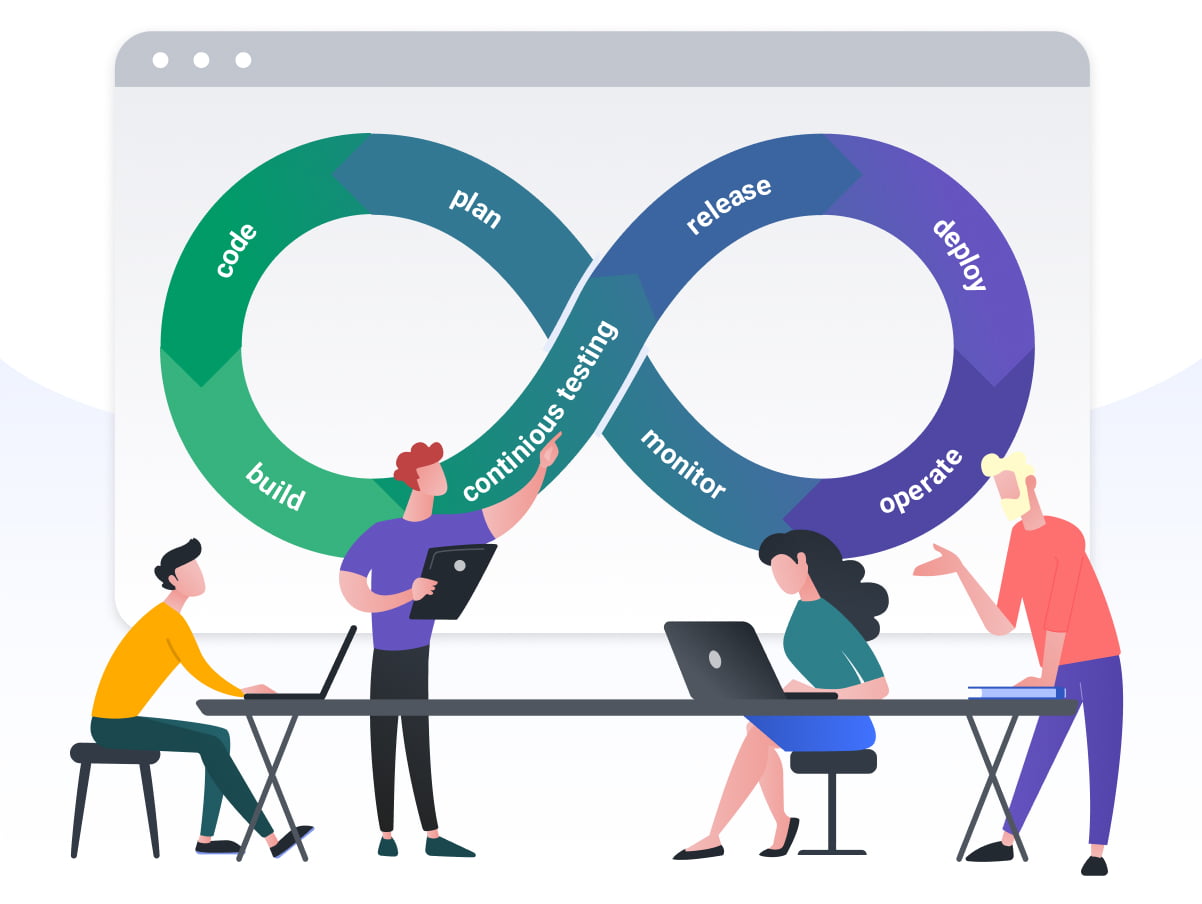In the intricate world of software development, principles act as the guiding stars. They provide a framework, ensuring that software is not only functional but also efficient, maintainable, and user-friendly. Currently, the number of software developers will grow to 28.7 million in 2024, with 84.7% of them working on software development projects focused on enterprise automation.
As the importance of productivity becomes one of the biggest questions for IT professionals and CTOs, McKinsey analyzed the strategies for measuring software development productivity. As more companies start developing their in-house tech teams or partnering with external talent, understanding what can improve productivity has become more important than ever.
Let's explore these foundational principles that shape the realm of software, help teams be more productive, and offer stellar products.

Principles of Software Development
SOLID Principles Explained
SOLID is an acronym coined by Robert C. Martin (Uncle Bob), representing five principles of object-oriented programming and design. These principles, when applied together, make it more likely that a programmer will create a system that is easy to maintain and extend over time.
Single Responsibility Principle (SRP)
Definition: A class should have one, and only one, reason to change.
Explanation: This principle states that every module or class should be responsible for a single part of the software's functionality. This responsibility should be entirely encapsulated by the class.
Example: Instead of having a class User that handles user data, authentication, and sending emails, split it into:
User: Manages user dataAuthenticator: Handles authenticationEmailService: Manages email sending
Benefits:
- Easier to understand and maintain
- Reduces coupling
- Easier to test
Open-Closed Principle (OCP)
Definition: Software entities (classes, modules, functions, etc.) should be open for extension but closed for modification.
Explanation: This principle suggests that you should be able to extend a class's behavior without modifying it. This is typically achieved through abstractions and polymorphism.
Example:
Instead of modifying a PaymentProcessor class every time you add a new payment method, use an interface:
class PaymentMethod:
def process_payment(self, amount):
pass
class CreditCardPayment(PaymentMethod):
def process_payment(self, amount):
# Credit card specific logic
class PayPalPayment(PaymentMethod):
def process_payment(self, amount):
# PayPal specific logicBenefits:
- Easier to add new functionality
- Reduces the risk of breaking existing code
- Promotes loose coupling
Liskov Substitution Principle (LSP)
Definition: Objects of a superclass should be replaceable with objects of its subclasses without affecting the correctness of the program.
Explanation: This principle ensures that a derived class can assume the place of its base class without causing any unexpected behavior.
Example:
If you have a Bird class with a fly method, and you create a Penguin subclass, it violates LSP because penguins can't fly. A better design might be:
class Bird:
def move(self):
pass
class FlyingBird(Bird):
def move(self):
return "Flying"
class SwimmingBird(Bird):
def move(self):
return "Swimming"Benefits:
- Ensures that inheritance is used correctly
- Reduces unexpected behavior in polymorphic code
- Improves code reusability
Interface Segregation Principle (ISP)
Definition: No client should be forced to depend on methods it does not use.
Explanation: This principle suggests that it's better to have many smaller, specific interfaces rather than a few large, general-purpose interfaces.
Example:
Instead of having a large Worker interface with methods for all possible jobs, create separate interfaces:
class Eatable:
def eat(self):
pass
class Workable:
def work(self):
pass
class Sleepable:
def sleep(self):
pass
class Human(Eatable, Workable, Sleepable):
# Implement methodsBenefits:
- Reduces the impact of changes
- Promotes decoupling
- Makes the system more flexible
Dependency Inversion Principle (DIP)
Definition: High-level modules should not depend on low-level modules. Both should depend on abstractions. Abstractions should not depend on details. Details should depend on abstractions.
Explanation: This principle suggests that you should depend on abstractions (interfaces or abstract classes) instead of concrete implementations.
Example:
Instead of having a NotificationService directly depend on an EmailSender, use an abstraction:
class NotificationSender:
def send(self, message):
pass
class EmailSender(NotificationSender):
def send(self, message):
# Email specific logic
class SMSSender(NotificationSender):
def send(self, message):
# SMS specific logic
class NotificationService:
def __init__(self, sender: NotificationSender):
self.sender = sender
def notify(self, message):
self.sender.send(message)Benefits:
- Reduces coupling between modules
- Increases flexibility and reusability
- Makes the system more testable
By following these SOLID principles, developers can create more maintainable, flexible, and robust object-oriented software systems.
Applying SOLID principles is crucial for building software that remains adaptable and maintainable as requirements evolve. These concepts ensure that individual components are modular and can be modified without breaking the entire system. Many teams incorporate these best practices into their development workflows to improve long-term scalability and efficiency. If you’re looking for ways to refine your architecture, you might find insights from our experience in backend development and front-end development useful.
Applying SOLID principles isn't just a theoretical best practice—it's a proven way to ensure scalable and maintainable software. A great example is our work with Spektrix, where we helped design a highly adaptable white-label booking solution using Microsoft Azure. By leveraging structured software architecture and modular design, we enabled seamless integrations and scalability for arts and entertainment organizations.
Learn more about how these principles played a role in the Spektrix case study.
Simplicity: Keep It Simple, Stupid (KISS)
The KISS principle states that most systems work best if they are kept simple rather than made complicated. Therefore, simplicity should be a key goal in design, and unnecessary complexity should be avoided.
KISS is a design principle noted by the U.S. Navy in 1960. The KISS principle states that simplicity should be a key goal in design, and that unnecessary complexity should be avoided. It serves as a reminder for developers to aim for simplicity in their solutions.
Key Concepts
- Simplicity: Strive for the simplest solution that meets the requirements.
- Clarity: Write code that is easy to understand and maintain.
- Avoiding Over-engineering: Don't add functionality until it is necessary.
- Problem Solving: Break down complex problems into simpler parts.
Example
Consider a scenario where we need to calculate the average of a list of numbers:
Overly Complex Approach (Not Recommended):
def calculate_average(numbers):
total = 0
count = 0
for num in numbers:
total += num
count += 1
if count == 0:
return None
else:
average = total / count
return round(average, 2)
numbers = [1, 2, 3, 4, 5]
result = calculate_average(numbers)
print(f"The average is: {result}") KISS Approach (Recommended):
def calculate_average(numbers):
return sum(numbers) / len(numbers) if numbers else None
numbers = [1, 2, 3, 4, 5]
result = calculate_average(numbers)
print(f"The average is: {result:.2f}") Benefits
- Improved Readability: Simpler code is easier to read and understand.
- Easier Maintenance: Simple systems are easier to maintain and debug.
- Reduced Bugs: Less complex code typically means fewer places for bugs to hide.
- Faster Development: Simple solutions often lead to faster development and iteration.
- Better Collaboration: Simpler code is easier for team members to work with and modify.
Considerations
- Balance with Functionality: Ensure that simplicity doesn't come at the cost of necessary functionality.
- Scalability: Consider future needs and ensure that the simple solution can scale if needed.
- Context: What's considered "simple" can vary based on the team's expertise and project requirements.
- Refactoring: Be open to simplifying complex code through refactoring when appropriate.
The KISS principle encourages developers to seek the simplest possible solutions to problems. By doing so, they can create more maintainable, understandable, and efficient software. However, it's important to balance simplicity with the need for functionality and future scalability.

DRY: Don't Repeat Yourself
The DRY principle states that "Every piece of knowledge must have a single, unambiguous, authoritative representation within a system.
The DRY principle is about reducing repetition in software designs. It suggests that developers should extract common functionality and reuse it rather than writing the same code in multiple places. This principle applies not just to code, but to all representations of knowledge within a system, including database schemas, test plans, and documentation.
Key Concepts
- Code Reusability: Write reusable functions, classes, or modules instead of duplicating code.
- Abstraction: Create abstractions that can be applied in multiple contexts.
- Single Source of Truth: Maintain a single, authoritative source for each piece of knowledge in your system.
Example
Consider a scenario where we need to validate email addresses in multiple places in our application:
Violating DRY (Not Recommended):
def register_user(username, email):
if not re.match(r"[^@]+@[^@]+\.[^@]+", email):
raise ValueError("Invalid email")
# Rest of registration logic
def update_user_email(user, new_email):
if not re.match(r"[^@]+@[^@]+\.[^@]+", new_email):
raise ValueError("Invalid email")
# Rest of email update logic Following DRY (Recommended):
def is_valid_email(email):
return re.match(r"[^@]+@[^@]+\.[^@]+", email) is not None
def register_user(username, email):
if not is_valid_email(email):
raise ValueError("Invalid email")
# Rest of registration logic
def update_user_email(user, new_email):
if not is_valid_email(new_email):
raise ValueError("Invalid email")
# Rest of email update logic Benefits
- Maintainability: Changes only need to be made in one place, reducing the risk of inconsistencies.
- Readability: Code becomes more concise and easier to understand.
- Reduced Bugs: Fewer places for bugs to hide, and fixes can be applied universally.
- Easier Testing: With centralized logic, testing becomes more straightforward and comprehensive.
Considerations
- Over-DRYing: Be cautious of over-abstracting. Sometimes, what looks like duplication might be separate concerns that could change independently.
- Context: Always consider the specific context and requirements of your project when applying DRY.
- Balance: Strive for a balance between DRY code and code that is easy to understand and maintain.
By adhering to the DRY principle, developers can create more maintainable, efficient, and less error-prone codebases. However, like all principles, it should be applied thoughtfully and in conjunction with other best practices in software development.
YAGNI: You Aren't Gonna Need It
YAGNI is a principle of extreme programming (XP) that states a programmer should not add functionality until deemed necessary.
YAGNI is a reminder for developers to avoid implementing features or functionality based on speculation about future needs. It encourages focusing on current requirements and avoiding premature optimization or over-engineering.
Key Concepts
- Present Focus: Implement only what's needed for current requirements.
- Avoiding Speculation: Don't add functionality based on assumptions about future needs.
- Simplicity: Keep the codebase lean and focused.
- Iterative Development: Add features incrementally as they become necessary.
Example
Consider a scenario where we're building a user registration system:
Violating YAGNI (Not Recommended):
class User:
def __init__(self, username, email):
self.username = username
self.email = email
self.login_attempts = 0
self.last_login = None
self.preferred_language = None
self.is_premium = False
self.subscription_end_date = None
def register(self):
# Basic registration logic
pass
def update_login_attempts(self):
self.login_attempts += 1
def set_premium_status(self, is_premium, end_date):
self.is_premium = is_premium
self.subscription_end_date = end_date
def set_language_preference(self, language):
self.preferred_language = language Following YAGNI (Recommended):
class User:
def __init__(self, username, email):
self.username = username
self.email = email
def register(self):
# Basic registration logic
pass Benefits
- Reduced Complexity: Simpler codebase that's easier to understand and maintain.
- Faster Development: Focus on immediate needs leads to quicker delivery of essential features.
- Lower Costs: Avoid spending time and resources on unused features.
- Flexibility: Easier to adapt to changing requirements without unnecessary code getting in the way.
- Improved Focus: Development team stays focused on solving current, real problems.
Considerations
- Balance with Architecture: While avoiding speculative features, ensure the overall architecture can accommodate future growth.
- Communication: Clear communication with stakeholders about the YAGNI approach is crucial to manage expectations.
- Refactoring: Be prepared to refactor code as new requirements emerge.
- Domain Knowledge: YAGNI doesn't mean ignoring domain expertise; use judgment when deciding what's truly necessary.
The YAGNI principle helps teams focus on delivering value quickly by implementing only what is necessary. It promotes a lean, agile approach to software development. However, it should be applied judiciously, balancing immediate needs with a sensible level of planning for the future.
Separation of Concerns Principle

Definition
Separation of Concerns (SoC) is a design principle for separating a computer program into distinct sections, such that each section addresses a separate concern.
The principle states that software should be organized so that each part focuses on a specific functionality or aspect, with minimal overlapping between parts. This makes the software easier to develop, maintain, and understand.
Key Concepts
- Modularity: Dividing the program into separate, interchangeable components.
- Encapsulation: Keeping the internal workings of a component hidden from the outside.
- Single Responsibility: Each component should have one primary responsibility.
- Loose Coupling: Minimizing dependencies between different parts of the program.
Example
Consider a simple web application for a to-do list. Here's how we might apply Separation of Concerns:
Violating SoC (Not Recommended):
class TodoApp:
def __init__(self):
self.todos = []
def add_todo(self, task):
self.todos.append(task)
self.save_to_database()
self.update_ui()
def save_to_database(self):
# Code to save todos to database
pass
def update_ui(self):
# Code to update the user interface
pass
def render_page(self):
html = "<html><body>"
for todo in self.todos:
html += f"<p>{todo}</p>"
html += "</body></html>"
return html Following SoC (Recommended):
# Model
class TodoList:
def __init__(self):
self.todos = []
def add_todo(self, task):
self.todos.append(task)
# View
class TodoView:
def render(self, todos):
html = "<html><body>"
for todo in todos:
html += f"<p>{todo}</p>"
html += "</body></html>"
return html
# Controller
class TodoController:
def __init__(self, model, view):
self.model = model
self.view = view
def add_todo(self, task):
self.model.add_todo(task)
self.update_view()
def update_view(self):
todos = self.model.todos
return self.view.render(todos)
# Database Handler
class DatabaseHandler:
def save(self, todos):
# Code to save todos to database
pass
# Usage
model = TodoList()
view = TodoView()
controller = TodoController(model, view)
db = DatabaseHandler()
# Adding a todo
controller.add_todo("Learn SoC")
db.save(model.todos) Benefits
- Improved Maintainability: Changes to one section don't affect others.
- Enhanced Reusability: Components can be reused in different contexts.
- Easier Testing: Individual components can be tested in isolation.
- Simplified Development: Developers can focus on one aspect at a time.
- Better Collaboration: Different team members can work on different concerns simultaneously.
Considerations
- Overhead: Separating concerns can sometimes lead to more complex architectures.
- Balance: Over-separation can lead to unnecessary complexity.
- Context: The level of separation should be appropriate for the project size and complexity.
- Communication: Clear interfaces between components are crucial.

Code Reusability
Definition
Code reusability is the practice of designing and writing code in a way that allows it to be used in multiple contexts or applications with minimal modification.
The principle of code reusability encourages developers to create modular, flexible code components that can be easily reused across different parts of an application or even in different projects. This approach saves time, reduces redundancy, and promotes consistency in code quality and behavior.
Key Concepts
- Modularity: Breaking code into self-contained, independent modules.
- Abstraction: Hiding complex implementation details behind simple interfaces.
- Generalization: Writing code that can handle a variety of inputs or scenarios.
- Parameterization: Using parameters to make functions more flexible and reusable.
- Design Patterns: Utilizing established patterns that promote reusability.
Example
Let's consider an example of formatting dates in different ways:
Low Reusability Approach (Not Recommended):
def format_date_for_us(date):
return date.strftime("%m/%d/%Y")
def format_date_for_eu(date):
return date.strftime("%d/%m/%Y")
def format_date_for_iso(date):
return date.strftime("%Y-%m-%d")
# Usage
from datetime import datetime
date = datetime.now()
print("US format:", format_date_for_us(date))
print("EU format:", format_date_for_eu(date))
print("ISO format:", format_date_for_iso(date)) High Reusability Approach (Recommended):
def format_date(date, format_string):
return date.strftime(format_string)
# Usage
from datetime import datetime
date = datetime.now()
print("US format:", format_date(date, "%m/%d/%Y"))
print("EU format:", format_date(date, "%d/%m/%Y"))
print("ISO format:", format_date(date, "%Y-%m-%d"))
# Even more reusable with a dictionary of formats
date_formats = {
"US": "%m/%d/%Y",
"EU": "%d/%m/%Y",
"ISO": "%Y-%m-%d"
}
for format_name, format_string in date_formats.items():
print(f"{format_name} format:", format_date(date, format_string)) Benefits
- Reduced Development Time: Reusing existing code saves time in writing and testing.
- Improved Code Quality: Reused code is often more reliable as it has been tested in multiple contexts.
- Easier Maintenance: Changes only need to be made in one place, reducing the risk of inconsistencies.
- Consistency: Reusable components ensure consistent behavior across an application.
- Scalability: Well-designed reusable code can easily adapt to growing requirements.
Considerations
- Overengineering: Don't make code overly complex in an attempt to make it reusable for every possible scenario.
- Performance: Highly generalized code may sometimes be less performant than specialized code.
- Learning Curve: Reusable components might require more initial effort to understand and use correctly.
- Testing: Reusable code needs thorough testing to ensure it works correctly in all intended contexts.
A well-structured system divides responsibilities logically, making it easier to scale, debug, and maintain. This is particularly useful when working with distributed systems or modular architectures like microservices, where different components need to interact seamlessly. Understanding how to effectively separate concerns can make integrations between services smoother and more reliable, as seen in various approaches to application integration.

Continuous Integration and Continuous Deployment (CI/CD)
CI/CD is a method to frequently deliver apps to customers by introducing automation into the stages of app development. The main concepts attributed to CI/CD are continuous integration, continuous delivery, and continuous deployment.
CI/CD bridges the gaps between development and operation activities and teams by enforcing automation in building, testing and deploying applications. The process contrasts with traditional methods where all updates were integrated at one time at the end of a project.
Key Concepts
- Continuous Integration (CI): Developers merge their changes back to the main branch as often as possible. The developer's changes are validated by creating a build and running automated tests against the build.
- Continuous Delivery (CD): The process of automating the delivery of applications to selected infrastructure environments.
- Continuous Deployment (CD): Every change that passes all stages of your production pipeline is released to your customers. There's no human intervention, and only a failed test will prevent a new change to be deployed to production.
- Automated Testing: The use of software tools to execute pre-scripted tests on a software application before it is released into production.
- Version Control: A system that records changes to a file or set of files over time so that you can recall specific versions later.
Example CI/CD Pipeline
# .github/workflows/ci-cd.yml
name: CI/CD Pipeline
on:
push:
branches: [ main ]
pull_request:
branches: [ main ]
jobs:
build-and-test:
runs-on: ubuntu-latest
steps:
- uses: actions/checkout@v2
- name: Set up Python
uses: actions/setup-python@v2
with:
python-version: '3.x'
- name: Install dependencies
run: |
python -m pip install --upgrade pip
pip install -r requirements.txt
- name: Run tests
run: python -m unittest discover tests
deploy:
needs: build-and-test
runs-on: ubuntu-latest
if: github.ref == 'refs/heads/main' && github.event_name == 'push'
steps:
- uses: actions/checkout@v2
- name: Deploy to production
run: |
echo "Deploying to production server"
# Add your deployment script here Benefits
- Faster Time to Market: Automates the software release process.
- Improved Product Quality: Detects bugs early through automated testing.
- Reduced Risk: Smaller code changes are easier to troubleshoot.
- Cost Reduction: Automation reduces manual work and associated costs.
- Better Collaboration: Encourages communication between developers, operations, and testing teams.
Considerations
- Initial Setup: Setting up a CI/CD pipeline can be complex and time-consuming.
- Maintenance: CI/CD pipelines require ongoing maintenance and updates.
- Cultural Shift: Requires a shift in organizational culture towards automation and frequent releases.
- Security: Automated deployments need robust security measures to prevent vulnerabilities.
Continuous integration and deployment practices streamline software delivery by automating testing and reducing deployment risks. However, implementing these pipelines effectively requires thoughtful tool selection and infrastructure planning. Many organizations use technologies like Kubernetes and Jenkins to manage their CI/CD processes efficiently. If you're exploring ways to enhance your DevOps workflow, strategies like those we apply in Kubernetes environments might be helpful.

Test-Driven Development (TDD)
Test-driven development (TDD) is a software development process that relies on repeating a very short development cycle: first, the developer writes an (initially failing) automated test case that defines a desired improvement or new function, then produces the minimum amount of code to pass that test, and finally, refactors the new code to acceptable standards.
TDD is a way of developing software by writing tests before writing the actual code. This approach ensures that the code meets its design and requirements, and leads to modular, flexible, and extensible code. It's often described as "Red, Green, Refactor" due to the colors used in most testing tools.
Key Concepts
- Red: Write a failing test for the desired functionality.
- Green: Write the minimum amount of code to make the test pass.
- Refactor: Improve the code without changing its functionality.
- Unit Tests: Tests that check the smallest testable parts of an application.
- Test Coverage: The degree to which the source code of a program is executed when a particular test suite runs.
Example
Let's walk through a TDD cycle for a simple function that checks if a number is even:
Step 1: Write a failing test (Red)
import unittest
class TestEvenChecker(unittest.TestCase):
def test_is_even(self):
self.assertTrue(is_even(2))
self.assertFalse(is_even(3))
if __name__ == '__main__':
unittest.main() Running this test will fail because we haven't defined the is_even function yet.
Step 2: Write the minimum code to pass the test (Green)
def is_even(number):
return number % 2 == 0
import unittest
class TestEvenChecker(unittest.TestCase):
def test_is_even(self):
self.assertTrue(is_even(2))
self.assertFalse(is_even(3))
if __name__ == '__main__':
unittest.main() Now the test passes.
Step 3: Refactor if necessary
In this case, our function is simple and doesn't require refactoring. In more complex scenarios, you might improve the code's structure or efficiency without changing its behavior.
Benefits
- Improved Code Quality: Writing tests first ensures that your code is testable by design.
- Better Design: TDD often leads to more modular, flexible code.
- Documentation: Tests serve as documentation for how the code should behave.
- Confidence in Changes: With a comprehensive test suite, developers can refactor with confidence.
- Reduced Debugging Time: Catching bugs early in the development process saves time.
Considerations
- Learning Curve: TDD requires a shift in thinking and can be challenging to adopt initially.
- Time Investment: Writing tests takes time, which can seem to slow down initial development.
- Maintenance: Tests need to be maintained along with the code they're testing.
- Overemphasis on Unit Tests: While valuable, unit tests shouldn't be the only form of testing.
Writing tests before writing the actual implementation might seem counterintuitive at first, but TDD often leads to more reliable and well-structured code. This approach ensures that new features don’t introduce unexpected issues and that developers can refactor code with confidence. Teams that prioritize quality assurance also benefit from regular code audits and peer reviews, similar to practices followed in various software development projects.

Agile Methodology
Agile methodology is an approach to project management and software development that helps teams deliver value to their customers faster and with fewer headaches. Instead of betting everything on a "big bang" launch, an agile team delivers work in small, but consumable, increments.
Agile is based on the idea that software development projects can be more flexible and responsive to change if they are divided into smaller incremental builds. This contrasts with traditional "Waterfall" development, which typically involves long development cycles with a single, large product delivery at the end.
Key Concepts
- Iterative Development: Work is divided into short cycles (typically 1-4 weeks) called sprints.
- Continuous Delivery: Working software is delivered frequently (weeks rather than months).
- Flexibility: Embrace changing requirements, even late in the development process.
- Collaboration: Business people and developers work together daily throughout the project.
- Self-organizing Teams: The best architectures, requirements, and designs emerge from self-organizing teams.
Agile Manifesto
The Agile Manifesto, created in 2001, outlines the core values of Agile methodology:
We are uncovering better ways of developing software by doing it and helping others do it. Through this work we have come to value:
- Individuals and interactions over processes and tools
- Working software over comprehensive documentation
- Customer collaboration over contract negotiation
- Responding to change over following a plan
That is, while there is value in the items on the right, we value the items on the left more. Example: Scrum Framework
Scrum is one of the most popular frameworks for implementing Agile. Here's a basic outline of how it works:
- Product Backlog: A prioritized list of features or requirements.
- Sprint Planning: The team selects items from the Product Backlog to work on during the upcoming Sprint.
- Sprint: A time-boxed period (usually 2-4 weeks) where the team works to complete the selected items.
- Daily Scrum: A brief daily meeting where team members synchronize their work and discuss any obstacles.
- Sprint Review: At the end of the Sprint, the team demonstrates the completed work to stakeholders.
- Sprint Retrospective: The team reflects on the past Sprint and identifies improvements for the next one.
Benefits
- Faster Time to Market: Regular releases allow for quicker delivery of features.
- Higher Quality: Continuous testing and integration lead to fewer bugs and higher quality software.
- Increased Customer Satisfaction: Regular customer feedback ensures the product meets their needs.
- Better Adaptability: Teams can quickly adapt to changing requirements or market conditions.
- Improved Team Morale: Self-organizing teams and regular achievements boost morale.
Considerations
- Cultural Shift: Adopting Agile often requires a significant change in organizational culture.
- Time Commitment: Regular meetings and constant communication require time and dedication.
- Scope Creep: Flexibility can sometimes lead to continually expanding project scope.
- Documentation: While valued, comprehensive documentation may receive less emphasis than in traditional methods.
Technology choices impact not only how software is built but also how maintainable and scalable it becomes. Using modern frameworks like React for dynamic interfaces or leveraging full-stack JavaScript solutions can help teams move faster while maintaining consistency across applications. When evaluating which technologies to use, considering how they fit into long-term goals—such as cross-platform compatibility or backend scalability—can make a significant difference. Our experience with various tech stacks has shown that choosing the right tools early on often leads to smoother development down the road.
Version Control
Version control is a system that records changes to a file or set of files over time so that you can recall specific versions later. It allows you to revert files or the entire project to a previous state, compare changes over time, see who last modified something that might be causing a problem, who introduced an issue and when, and more.
Version control systems (VCS) are essential tools in modern software development. They help teams collaborate, maintain different versions of software, and keep track of modifications. Git is currently the most widely used version control system.
Key Concepts
- Repository: A directory where your project's files and version history are stored.
- Commit: A snapshot of your files at a specific point in time.
- Branch: A parallel version of a repository that allows you to work freely without disrupting the main version.
- Merge: The process of integrating changes from one branch into another.
- Pull Request: A method of submitting contributions to a project, often used for code review.
Example: Basic Git Workflow
Here's a simple example of how you might use Git in a typical workflow:
# Clone a repository
git clone https://github.com/username/project.git
# Create a new branch
git checkout -b feature-branch
# Make changes to files
# Stage changes
git add .
# Commit changes
git commit -m "Add new feature"
# Push changes to remote repository
git push origin feature-branch
# Create a pull request on GitHub
# After review, merge the pull request
# Switch back to main branch
git checkout main
# Pull latest changes
git pull origin main Benefits
- History and Revertibility: Ability to view the full history of a project and revert to previous versions if needed.
- Collaboration: Multiple developers can work on the same project without conflicts.
- Branching and Merging: Allows for parallel development and experimentation without affecting the main codebase.
- Backup: Distributed version control systems like Git provide an inherent backup mechanism.
- Traceability: Every change is tracked, allowing you to see who made what changes and when.
Considerations
- Learning Curve: Version control systems can be complex and take time to master.
- Overhead: Using version control adds some extra steps to the development process.
- Large Files: Most VCS are not optimized for large binary files or datasets.
- Merge Conflicts: When multiple developers modify the same part of a file, resolving conflicts can be challenging.

Code Reviews
A code review is a software quality assurance activity in which one or several people check a program mainly by viewing and reading parts of its source code. At least one of the persons must not be the code's author.
Code reviews are systematic examinations of source code intended to find and fix mistakes overlooked in the initial development phase. They improve both software quality and developers' skills. This process is an essential part of many software development methodologies.
Key Concepts
- Peer Review: Developers review each other's code, providing feedback and suggestions.
- Static Code Analysis: Using tools to automatically check code for potential issues.
- Pull Request: A method of submitting contributions to a project, often used as a venue for code review.
- Continuous Integration: Automating the integration of code changes from multiple contributors into a single software project.
- Code Standards: Agreed-upon conventions for writing code within a team or organization.
Example: Code Review Process
Here's a typical code review process:
- Developer completes a feature or bug fix.
- Developer creates a pull request (PR) with their changes.
- One or more reviewers are assigned to the PR.
- Reviewers examine the code, leaving comments and suggestions.
- Developer addresses the feedback, making necessary changes.
- Reviewers approve the changes once satisfied.
- The code is merged into the main branch.
Example: Code Review Comments
Here are some examples of constructive code review comments:
// Original code
for (int i = 0; i < list.size(); i++) {
if (list.get(i).isValid()) {
validItems.add(list.get(i));
}
}
// Review comment:
// "Consider using a stream or list comprehension for better readability:
// validItems = list.stream().filter(Item::isValid).collect(Collectors.toList());"
// Another example
public void processData(String data) {
// process the data
}
// Review comment:
// "It's a good practice to validate input parameters.
// Consider adding a null check for 'data' at the beginning of this method." Benefits
- Improved Code Quality: Catching bugs and design issues early in the development process.
- Knowledge Sharing: Team members learn from each other's code and techniques.
- Consistent Coding Standards: Ensuring the codebase follows agreed-upon conventions.
- Mentoring: Senior developers can guide junior developers through reviews.
- Collective Code Ownership: The team as a whole becomes responsible for the codebase.
Considerations
- Time Investment: Code reviews can be time-consuming and may slow down the development process initially.
- Potential for Conflict: Disagreements about code style or implementation can arise.
- Scope: Determining what aspects of the code to focus on during reviews.
- Reviewer Fatigue: Reviewing large amounts of code can be mentally taxing.
Code reviews are a crucial part of the software development process, contributing to higher code quality, better team collaboration, and ongoing skill development for all team members. While they require time and effort, the long-term benefits in terms of reduced bugs, improved maintainability, and team knowledge sharing make them an invaluable practice in professional software development.
Third-Party Code Audit Companies
While internal code reviews are crucial, some organizations also employ third-party code audit companies for additional assurance, especially for critical systems or to meet regulatory requirements.
Third-party code audits involve hiring external, independent companies to review and analyze your codebase. These companies specialize in code quality, security, and compliance assessments.
Key Aspects of Third-Party Code Audits
- Objective Assessment: Provides an unbiased view of code quality and security.
- Specialized Expertise: Audit companies often have experts in specific areas like security or performance optimization.
- Compliance Checks: Ensures code meets industry standards and regulatory requirements.
- Advanced Tools: Utilizes sophisticated static and dynamic analysis tools.
- Comprehensive Reports: Delivers detailed findings and recommendations for improvement.
When to Consider Third-Party Audits
- Before major releases of critical software
- When dealing with sensitive data or systems
- To meet regulatory compliance requirements
- When acquiring or merging with another company
- Periodically for large, complex codebases
Benefits of Third-Party Audits
- Fresh Perspective: Identifies issues that internal teams might overlook.
- Risk Mitigation: Helps prevent security breaches and critical bugs.
- Credibility: Provides assurance to stakeholders and customers.
- Knowledge Transfer: Internal teams can learn from audit findings and methodologies.
Considerations
- Cost: Third-party audits can be expensive, especially for large codebases.
- Time: The audit process can take significant time, potentially impacting development schedules.
- Scope Definition: Clearly defining the audit scope is crucial for effective results.
- Confidentiality: Ensure proper NDAs and data handling procedures are in place.

Documentation in Software Development
Documentation in software development is the process of recording information about the software's design, architecture, functions, APIs, and usage. It serves as a guide for developers, users, and stakeholders to understand and use the software effectively.
Good documentation is crucial for a software project's long-term success. It helps new developers onboard quickly, assists users in understanding how to use the software, and provides a reference for future maintenance and updates.
Types of Documentation
- Code Documentation: Comments and docstrings within the code itself.
- API Documentation: Detailed explanations of functions, classes, and modules.
- Technical Documentation: Information about the system architecture, data models, etc.
- User Documentation: Guides and tutorials for end-users of the software.
- Project Documentation: Information about the development process, timelines, and decisions.
Example: Code Documentation
Here's an example of well-documented Python code:
def calculate_area(length: float, width: float) -> float:
"""
Calculate the area of a rectangle.
Args:
length (float): The length of the rectangle.
width (float): The width of the rectangle.
Returns:
float: The area of the rectangle.
Raises:
ValueError: If length or width is negative.
Example:
>>> calculate_area(5, 3)
15.0
"""
if length < 0 or width < 0:
raise ValueError("Length and width must be non-negative")
return length * width Best Practices
- Keep it Updated: Documentation should evolve with the code.
- Be Clear and Concise: Use simple language and avoid jargon when possible.
- Use Examples: Provide code snippets and use cases.
- Structure Properly: Organize documentation logically for easy navigation.
- Automate When Possible: Use tools to generate documentation from code comments.
Benefits
- Improved Maintainability: Makes it easier for developers to understand and modify code.
- Faster Onboarding: Helps new team members get up to speed quickly.
- Better Collaboration: Facilitates communication between team members and with stakeholders.
- Reduced Support Burden: Good user documentation can decrease the number of support requests.
- Historical Record: Provides insights into why certain decisions were made.
Challenges
- Time-consuming: Writing and maintaining documentation takes significant effort.
- Keeping it Updated: Documentation can quickly become outdated if not regularly maintained.
- Finding the Right Balance: Over-documentation can be as problematic as under-documentation.
- Accessibility: Ensuring documentation is easily accessible and searchable for all who need it.

Security by Design in Software Development
Security by Design is an approach to software and hardware development that aims to make systems as free of vulnerabilities and impervious to attack as possible through measures such as continuous testing, authentication safeguards, and adherence to best programming practices.
Security by Design involves integrating security measures throughout the software development lifecycle rather than treating it as an afterthought. This proactive approach helps to identify and mitigate potential security risks early in the development process, resulting in more secure and robust software systems.
Key Principles
- Least Privilege: Users and processes should have the minimum levels of access necessary to perform their functions.
- Defense in Depth: Implement multiple layers of security controls throughout the system.
- Fail-Safe Defaults: The default state of the system should be secure.
- Complete Mediation: Every access to every object must be checked for authority.
- Open Design: Security should not depend on the secrecy of the implementation.
- Separation of Duties: Split critical functions among different entities.
- Psychological Acceptability: Security mechanisms should not make the resource more difficult to access than if they were not present.
Example: Secure Password Storage
Here's an example of how to securely store passwords using bcrypt in Python:
import bcrypt
def hash_password(password: str) -> bytes:
"""
Hash a password for storing.
Args:
password (str): The password to hash.
Returns:
bytes: The hashed password.
"""
# Generate a salt and hash the password
salt = bcrypt.gensalt()
hashed = bcrypt.hashpw(password.encode('utf-8'), salt)
return hashed
def check_password(password: str, hashed: bytes) -> bool:
"""
Check a password against its hash.
Args:
password (str): The password to check.
hashed (bytes): The hashed password to check against.
Returns:
bool: True if the password matches, False otherwise.
"""
return bcrypt.checkpw(password.encode('utf-8'), hashed)
# Usage
password = "mysecurepassword"
hashed_password = hash_password(password)
print(check_password(password, hashed_password)) # True
print(check_password("wrongpassword", hashed_password)) # False Best Practices
- Input Validation: Validate and sanitize all user inputs to prevent injection attacks.
- Encryption: Use strong, up-to-date encryption algorithms for sensitive data.
- Authentication and Authorization: Implement robust authentication mechanisms and proper access controls.
- Error Handling: Implement secure error handling that doesn't reveal sensitive information.
- Regular Updates: Keep all software components and libraries up-to-date.
- Security Testing: Conduct regular security audits and penetration testing.
Benefits
- Reduced Vulnerabilities: Identifying and addressing security issues early in the development process.
- Cost Efficiency: It's often less expensive to build security in from the start than to add it later.
- Improved Compliance: Helps meet regulatory requirements and industry standards.
- Enhanced Trust: Builds user confidence in the software's security.
- Faster Time-to-Market: Reduces delays caused by security issues found late in development.
Challenges
- Complexity: Implementing comprehensive security measures can add complexity to the development process.
- Evolving Threats: The security landscape is constantly changing, requiring ongoing vigilance and updates.
- Balance with Usability: Overly strict security measures can negatively impact user experience.
- Resource Intensive: Implementing Security by Design requires dedicated time, effort, and expertise.
Security should be considered at every stage of development, from architecture planning to deployment. Implementing principles like least privilege, encryption, and regular security assessments helps protect applications from vulnerabilities. In some cases, leveraging blockchain technology or secure application architectures can add an extra layer of trust and protection. Exploring solutions like secure software design can provide additional insights into best practices for safeguarding applications.

Performance Optimization in Software Development
Performance Optimization is the process of improving the speed, efficiency, and resource utilization of a software application. It involves identifying and eliminating bottlenecks, reducing computational complexity, and enhancing the overall user experience.
Performance optimization is crucial for creating responsive, efficient, and scalable software. It encompasses various techniques and strategies applied at different levels of software development, from algorithmic improvements to system-level optimizations.
Key Areas of Focus
- Algorithm Efficiency: Improving the time and space complexity of algorithms.
- Data Structure Selection: Choosing appropriate data structures for efficient data manipulation and storage.
- Database Optimization: Optimizing queries, indexing, and database schema for faster data retrieval and manipulation.
- Caching: Implementing caching mechanisms to reduce repeated computations or database calls.
- Concurrency and Parallelism: Utilizing multi-threading and parallel processing to improve performance on multi-core systems.
- Network Optimization: Reducing latency and improving throughput in networked applications.
- Memory Management: Efficient allocation and deallocation of memory resources.
Example: Optimizing a Fibonacci Function
Here's an example of optimizing a Fibonacci number calculator using memoization:
# Unoptimized recursive version
def fibonacci_unoptimized(n):
if n <= 1:
return n
return fibonacci_unoptimized(n-1) + fibonacci_unoptimized(n-2)
# Optimized version using memoization
def fibonacci_optimized(n, memo={}):
if n in memo:
return memo[n]
if n <= 1:
return n
memo[n] = fibonacci_optimized(n-1, memo) + fibonacci_optimized(n-2, memo)
return memo[n]
# Usage and timing
import time
n = 35
start = time.time()
fibonacci_unoptimized(n)
end = time.time()
print(f"Unoptimized time: {end - start:.5f} seconds")
start = time.time()
fibonacci_optimized(n)
end = time.time()
print(f"Optimized time: {end - start:.5f} seconds") Best Practices
- Profiling: Use profiling tools to identify performance bottlenecks.
- Benchmarking: Regularly benchmark your application to track performance improvements or regressions.
- Lazy Loading: Load resources only when they are needed.
- Efficient I/O Operations: Optimize disk and network I/O operations.
- Code Optimization: Write clean, efficient code and use compiler optimizations when applicable.
- Resource Pooling: Implement resource pooling for expensive resources like database connections.















